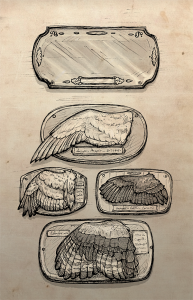An essay by an anonymous collector, as provided by H. Pueyo
Art by Leigh Legler
The anatomy of their bodies is quite singular–a single head, two normal arms and legs of varying sizes, a common torso of proportionate shape, slightly wider to fit their potent lungs, feet en pointe like a ballerina, with claws instead of nails, and two long, magnificent wings. Each of their kind tends to have certain similar features: peacocks with their low flights and impressive males, nightingales with tedious colors but remarkable singing, the terrestrial variety known as “the chicken,” ravens as black as night, and the large blue macaws.
Only legends mention a creature so rare it is said to be born only once every fifty years, always of genitors of different phenotypes in a solitary egg at the top of the highest tree. They call it the bird-of-paradise, and it sings more beautifully than any living bird, only to die, tragically, disappearing for the following half-century. As a collector, I have been both skeptical and fascinated by the story, as determined to find the truth as I am to find a new subspecies to add to my own, particular compilation.
~
Thirty-seven days, five trebuchets, two thousand men and women, and a large amount of intricate iron nets–that’s what it took to capture him. Birds can be borderline impossible to hunt, considering their location is far beyond the reach of any other intelligent species, so we had to camp for weeks under the dense tropical vegetation. In the past, my species has committed the heinous mistake of logging, which only caused them to grow suspicious and move with a frequency. Now, we wait until they appear flying. The chickens are, in theory, more endangered, but we rarely pay them any attention. They live inside the hollow trunks of large trees, and spy on us from the little holes they make, and use that to warn the birds from up above.
Each habitable tree is so tall one cannot possibly see where they end, and they are believed to be at least 120 meters in average. The trunks are also incredibly thick and spacious, capable of supporting the different constructions those tricky beasts make inside them. Ignorant individuals have tried to climb them countless times, and the few who lived have discovered some valuable information. One–short-distance types like fowls and peacocks live in the lower levels, and are able to fly inside the trees as well, with the help of wooden branches. Two–this is how they communicate with soaring and gliding birds. Three–although there is no way to enter the trees from the outside, only from above, at certain heights you can find external terraces on which to rest. And four, and most important–the trees are clogged with enormous hives of deadly wasps and bees.
So we wait in the middle of the fetid mangrove, fight mosquitoes, and take turns in bird watching. We eat from palms and small animals, drink sweetwater, and observe from day to night below the crown shyness, the unbearable humidity, and the shades of emerald, turquoise, and aquamarine.
“Anything?” I ask that same afternoon, preparing one of the nets. The chickens decided to welcome us with a gift: hanging from branches, about 20 pair of horns bump softly against each other with the breeze. The horns of my people, from hunters like me. Dark and light, twisted, short, medium and long, protuberant and smooth, made of the special keratin quartz and ivory growing from our skulls. I point to the horns, carved with the specific symbols of the birds like wooden work. “How lovely.”

Albeit a humble wing collector, I do enjoy the pleasures of music, and I’d rather hear their songs before pinning their disembodied wings to my walls. “Sing for me.”
To read the rest of this story, check out the Mad Scientist Journal: Winter 2018 collection.
Little is known about the life of this anonymous collector. While his work as an ornithologist is recognized worldwide, and his collection of wings, feathers, and illustrations of alários of the most varied subspecies have been donated to museums after his death, he left very few clues about his personal affairs. For more information, see the book Musings of a Wing Collector: The Anonymous Ornithologist’s Incomplete Journals, published postmortem earlier this year.
H. Pueyo is an Argentine-Brazilian writer and translator. Her work can be read in venues such as Strange Horizons, Clarkesworld and The Dark Magazine, among others.
Leigh’s professional title is “illustrator,” but that’s just a nice word for “monster-maker,” in this case. More information about them can be found at http://leighlegler.carbonmade.com/.
“The Wing Collector” is Copyright 2017 H. Pueyo
Art accompanying story is Copyright 2017 Leigh Legler
